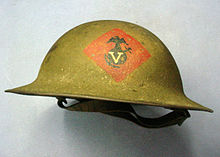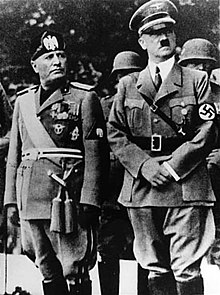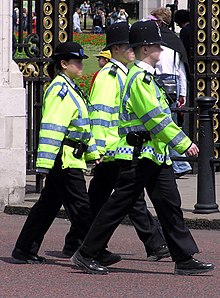uniform
As Uniform (colloquially gap , Austro often regalia ) refers to similar clothing to optically uniform (Latin-French: uniform) in the public act. In the military, uniform is a necessary condition for combatant status .
meaning
The uniform symbolizes the function of its wearer and / or his affiliation with an association and an organization (clothing, badge , national flag, etc.). By wearing the uniform, the individual should embody his or her profession or task and place his or her function as a functionary in the foreground. With the wearing of the uniform, the corps spirit of the uniform is also developed and strengthened.
Uniforms are either mandatory (e.g. in public service ) or customary. Soldiers , members of auxiliary services and law enforcement officers on missions abroad are also obliged to wear uniforms due to international law .
Uniforms are worn when performing work (service uniform, work clothes) and on certain occasions, e.g. B. at ceremonies . The military is a complex structure with a wide variety of designs, ways of wearing and designations (e.g. combat suit ). Today's uniforms should be practical, easy to care for and have lots of pockets, while the old uniforms looked more like a gala uniform .
In addition to a uniform appearance, a good uniform usually has important individual characteristics. These help both internal and external people to orientate themselves about the position of a uniformed person. Even without knowledge of rank badges z. B. by job badges, medals, etc. It is easy to see what experience the person wearing the uniform has.
Furthermore, uniforms serve several practical purposes: By representing the official uniform of the wearer, they make it easy for others to recognize and address his function or office. Furthermore, uniforms in the military are also intended for camouflage or, in the public service, for visual recognition by means of luminous signal colors.
history

The history of military clothing has always been accompanied by social and economic developments. As long as the peoples of the ancient world only deployed armed forces in the event of war, the respective typical folk clothing was usually sufficient to differentiate in the field . With the establishment of a standing force like the Roman legions , it became necessary to equip them with clothing, weapons and armor . Since these could be obtained most cheaply through early forms of mass production, an extensive standardization of the appearance automatically occurred. With the fall of the Roman Empire , these early forms of uniform disappeared. In the early Middle Ages , soldiers carried the flag with the coat of arms of their sovereign on campaigns in Central Europe, making themselves recognizable as an enemy combat unit. Only the bodyguards of the rulers, knights and city guards wore uniform clothing in some places. As early as 1309, however, the term vestitura uniformis ( Latin : "uniform clothing") was used for the four hundred knights who accompanied Duke Friedrich of Austria to Speyer .
With the decline of the classic feudal armies and the increasing commercialization of warfare by mercenary armies in the 15th century, the regimental economy developed towards the end of the 16th century : The owners of a regiment were war entrepreneurs who recruited mercenaries on their own account on behalf of the warring princes, armed, equipped and paid for them to then make them available to the client for money under their command. As a rule, the regiment chief also provided his regiment with food and, later, clothing and equipment on his own account, the price for this was then deducted from the soldiers' pay. Substantial profits could be achieved through bulk purchase or own production. The prototype of such an entrepreneur was Wallenstein , the imperial generalissimo in the Thirty Years' War , who raised an army of 200,000 men for the emperor based on this model. The collective procurement of equipment and clothing resulted in a fairly uniform appearance within the troops set up in this way. With the formation of the standing armies and the improvement of the production possibilities of the textile factories , uniforms continued from the middle of the 17th century to the 18th century. The cut of the uniform skirt was mostly (albeit with some delay) based on contemporary civilian fashion, but to differentiate (=> avoiding friendly fire ) on the battlefield, mostly strong colors were chosen , so that "the colorful skirt" (or later " Tabard ”) has long been synonymous with army uniforms and military service.
By 1720 almost all European armies were in uniform. The typical basic colors of the uniforms come from this time: The armies of Protestant states wore dark blue (e.g. in Prussia , Hesse-Kassel and Sweden) or red skirts (e.g. in England , Hanover, Denmark-Norway), while in Catholic states such as France , Poland , Austria or Spain wore light gray or from around 1730 white skirts. Russia chose their own typical uniform color with dark green and Bavaria with light blue. The characteristic colors were soon generally associated with the respective nations (e.g. " red coat " or " Prussian blue " ), even if large parts of the army (especially the cavalry) were uniformly colored differently. In order to differentiate between individual units within the same branch of service, different button colors were used in addition to the badge colors. Trimmings and the shape of cuffs and lap pockets were further distinguishing features.
In Prussia it was not until the time of Frederick II that today's term uniform replaced the terms livery or mount . This is where the term outfit comes from, which is used colloquially instead of uniform. Uniforms have been used in civilian life since the Middle Ages. In the 18th and 19th centuries, civil uniforms also existed for the civil state .
With the change in tactics from the rifle line to the approach using cover around 1900, the requirements for the uniform changed. In the 19th century the troops, especially the cavalry , went into the field in colorful outfits. The rapid progress in the performance parameters of firearms (e.g. accuracy , firing range , cadence , low-smoke powder ) then made changes inevitable. Massive combat orders and flashy uniforms became dysfunctional.
At the end of the 19th century, single-colored camouflaging uniforms and camouflage colors were experimented with for the first time .
At the latest in World War I , the uniforms were given a camouflage color. The colored and extensively crafted uniform that had dominated the picture until then was divided into different types of uniform for different purposes, the main features of which are still valid today. The parade uniform for ceremonial occasions, from which the formal suit or gala uniform for officers developed. A dress uniform , the usually simpler day service uniform , the work uniform for dirty work of the crews and NCOs (see also: Drillich ), and the field uniform. The colors of the field uniform were adapted to the respective environment (camouflage color and camouflage structure). First in 1901, during the Boer War , the British Army introduced a brownish uniform color known as khaki for the troops stationed at home . For the new German field uniform introduced in 1910, the colors field gray and gray green (hunter troop) were chosen. These replaced the previously used Prussian blue or light blue (Bavaria), dark green (hunter troop) and the other color combinations of the cavalry. The special badge colors of individual associations were replaced by uniform weapon colors for entire branches of the army.

Since the beginning of 1915 we proceeded to assaults of the infantry in trench warfare by hours of artillery fire to prepare. Above all, fragmentation and shrapnel projectiles were used , which had a devastating effect. In order to reduce the losses, the previously used headgear was replaced by the steel helmet . The helmets of different nations differed markedly in their shape; that helped distinguish between friend and foe.
The wearing of uniforms was banned for civilians in the Weimar Republic from 1921 by a decree of the Reich President Friedrich Ebert . His successor, Field Marshal Paul von Hindenburg , lifted the uniform ban on August 26, 1925. NSDAP and KPD introduced their own party clothing for their members (see also brown shirt ).
Uniforms were extremely widespread in Germany under the Nazi regime from 1933 to 1945. In addition to hundreds of thousands of members of the NSDAP and its organizations such as the SA and SS , the increasingly extensive military (including the Wehrmacht ), the Reich Labor Service , the police , the Reichsbahn and the post office were in uniform and most of the other state organs. The Nazi youth organizations Hitler Youth and the Association of German Girls and the National Political Educational Institutions (NAPOLA) were also uniformed.
In tsarist Russia and later in the Soviet Union , too , uniforms were noticeably common in the streets, especially in cities.
Types and designs
A uniform consists of a complete set of clothing, i. H. Headgear , outer clothing , trousers , footwear as well as rank badges and, if applicable, medals . In addition to the operational or field uniform for daily service, there are various designs. There are uniforms for representative occasions ( going out uniforms , the so-called "first set", parade uniforms , gala uniforms), special uniforms for areas of operation (e.g. at sea, in the mountains, in the tropics , in deserts and forests ) and operational tasks (e.g. B. technical service, alpine operation, closed operations ) or activities ( armored suit , flight suit , uniformed sports suit ).
In the public service, suit regulations are specified for the individual areas (e.g. suit regulations for soldiers in the Bundeswehr).
Coats of arms that can be seen on uniforms are called sleeve coats of arms , these are often provided with the name of the authorities.
carrier
- Soldiers (e.g. Bundeswehr uniforms )
- Police officers (unless members of the criminal police or in civilian clothes are on duty; see police uniform )
- Customs officers of the German Federal Customs Administration in the border clearance and border inspection service , in the mobile control groups and in the financial controls of illegal work .
- Prison officers (both magistrates at courts and civil servants in the general prison service and partly in the works service in prisons)
- Members of the technical relief organization (THW)
- Members of the Federal Office for Goods Transport (BAG), e.g. B. at roadside checks
- Commercial and commercial pilots ( captain / CPT, 1st officer / FO, in some cases: 2nd officer / SO, rarely: flight engineer / FE)
- Firefighters
- Rescue service members
- Guard service
- Servants , e.g. B. Maids, nannies , bellboys, porters
- Cooks and waiters (no uniform in the strict sense)
- Members of the merchant navy at sea, today only officers
- Protect
- Boy scouts , even if the German self- image speaks of a gown or costume , is the internationally, also in Austria, common name of the uniform.
- Port masters in some countries
Uniforms are also worn in the transport sector , especially in the railroad and post office , although the military character has been lost over the years in favor of a more civilian appearance (see e.g. Swiss railway uniforms ).
Others
In Germany, no uniforms may be worn in public as an expression of political convictions. Although this criminal offense is anchored in Section 3 of the Assembly Act (VersammlG) , it does not only apply to assemblies. The Front Deutscher Äpfel circumvents this ban by declaring it a street theater. The members are allowed to wear the typical armbands in their scenic design.
When the Bundeswehr was built up after the Second World War , the conscripted citizen in uniform was the new political model.
Wearing uniforms on passport photos is not permitted in Germany (except for ID cards ). In Germany, the unauthorized wearing of a uniform and items of clothing that are similar or that could lead to confusion is a criminal offense . This also applies to foreign uniforms and parts of uniforms ( offenses in accordance with Section 132a of the Criminal Code ). See also: Permit to wear uniform
The so-called robber civil or univilized is the wearing of parts of the uniform with civil clothing. This is usually not permitted, but is often done in this way by mercenaries , militias and also regular troops from some countries in war and crisis areas. Robber civilian clothes also include negligent, inappropriate clothing.
The abuse of a uniform by Captain von Köpenick became known .
In Austria the uniforms and uniform parts of the organs of the security service and the judicial guard as well as the soldiers are placed under legal protection. Except for scenic purposes (e.g. filming or theater performances), it is not permitted to wear such a uniform or uniform parts (badges, distinctions and the like) in a public place. Anyone who violates this can face an administrative fine of up to 500 euros or, in the event of irrecoverability, a prison sentence of up to two weeks ( Section 83a SPG).
Assumption of office according to § 314 StGB is also a criminal offense in Austria, but wearing a uniform is not absolutely necessary.
In Switzerland , the unauthorized wearing of the military uniform is punishable under Art. 331 StGB .
See also
- Official costume
- Work clothing , service clothing
- Military headgear , infantryman of the future (IdZ), combat suit
- Scout attire
- Paroli (uniform)
- Adjustment
- Equalization (uniform)
- Historical uniforms of the THW
- Mao suit
- Uniforms of the Wehrmacht
- Uniforms of the Waffen-SS , uniforms of the SS
- Uniforms of the Imperial Navy
- Civil uniform
- school uniform
literature
- Nathan Joseph: Uniforms and Nonuniforms. Communication Through Clothing. Greenwood Press, New York 1986, ISBN 0-313-25195-9 .
- Elisabeth Hackspiel-Mikosch (Hrsg.), Stefan Haas (Hrsg.): The civil uniform as symbolic communication. Franz Steiner Verlag, Stuttgart 2006, ISBN 978-3-515-08858-9 .
- Regina Henkel: Corporate Fashion: Uniforms in companies. Edition Ebersbach, Berlin 2008, ISBN 3-869-15001-7 .
- Sandro Wiggerich (Ed.), Steven Kensy (Ed.): State Power Uniform. Franz Steiner Verlag, Stuttgart 2011, ISBN 978-3-515-09933-2 .
- Rolf Wirtgen : Uniforms in the NATO countries 1900 to today. Mittler, Herford u. a. 1989, ISBN 3-8132-0331-X .
- Marcel Bohnert : The multi-form carriers . Notes on the suit regulations in Afghanistan. In: The Panzer Grenadier . No. 34 , February 2013 ( PDF [accessed April 11, 2015]).
- Peter Fichtenbauer , Christian Ortner : The history of the Austrian army from Maria Theresa to the present in essays and pictorial representations, Verlag Militaria, Vienna 2015, ISBN 978-3-902526-71-7
Web links
- Historical uniforms of the German and Austrian troops (around 1698–1840), to a lesser extent also other European powers.
- Historic uniforms of the British Navy around 1799
- Suit regulations in the Austrian armed forces
- Collection of police uniforms in the Dettenhausen police station
- historical railway uniforms
Individual evidence
- ↑ Suit regulations for soldiers in the Bundeswehr. (PDF) In: https://www.reservisten.bundeswehr.de/ . Inner Guidance Center , October 1, 2019 .
- ↑ Federal Office for Goods Transport
- ↑ Offense according to § 3 Assembly Act (Germany)








